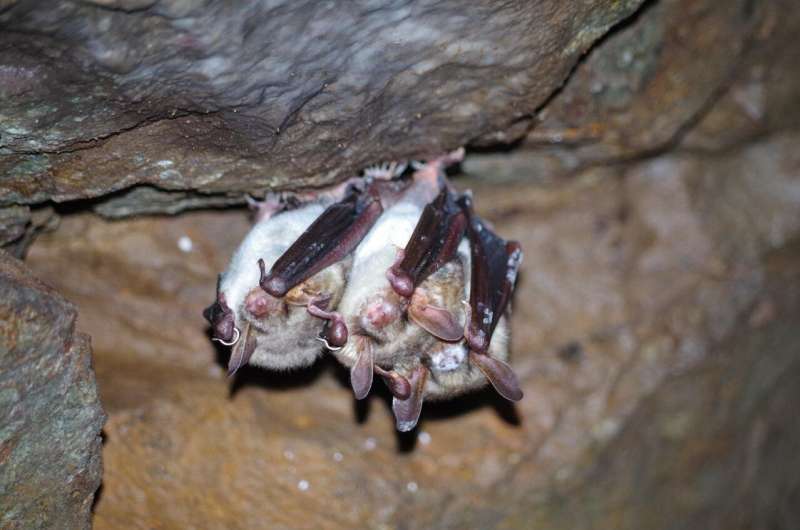European hibernating bats cope with white-nose syndrome which kills North American bats

Fungal diseases are a major threat to wildlife, sometimes resulting in significant population declines or even causing the extirpation of populations or species. White-nose syndrome, caused by the cold-loving fungus Pseudogymnoascus destructans, has become a major cause of death for hibernating bats in North America. European bats survive when infected by the same fungus during hibernation. What are the reasons for such a contrast in outcomes? A scientist team led by the Leibniz Institute for Zoo and Wildlife Research (Leibniz-IZW) has now analyzed the humoral innate immune defense of European greater mouse-eared bats to the fungus. In contrast to North American bats, European bats have sufficient baseline levels of key immune parameters and thus tolerate a certain level of infection throughout hibernation. The results are published in the journal Developmental and Comparative Immunology.
During infections caused by Pseudogymnoascus destructans (Pd), North American bats arouse frequently from hibernation to trigger a more elaborate immune response, whereas European bats remain dormant, owing, as the new results reveal, to their competent baseline immunity. Not being able to deal with the fungus by baseline immunity causes North American bats to deplete fat stores before the end of winter bnecause of the need for additional and energetically expensive arousals, which ultimately leads to their starvation. European bats may also arouse once in a while when infected but their strong baseline immunity allows them to balance the tight energy budget better during winter hibernation.
For this investigation, the scientists went to hibernation sites in Germany and studied 61 mouse-eared bats (Myotis myotis) with varying levels of natural infections by Pseudogymnoascus destructans. The animals were divided into three groups according to the severity of fungal infections (asymptomatic, mild symptoms, severe infection). Body mass and skeletal body size of bats was measured and blood samples taken from torpid animals. In addition, the team monitored in other conspecifics how often infected animals arose from hibernation. "We could show that there is no link between infection and the frequency of waking up from hibernation in the European greater mouse-eared bat," say Marcus Fritze and Christian C. Voigt, bat experts from the Department Evolutionary Ecology at Leibniz-IZW. "This is consistent with the idea that the fungus does not trigger an immune response in European hibernating bats but is rather kept under control by the bats' baseline immunity."
In contrast, North American bats such as little brown bats (Myotis lucifugus) arouse frequently when infected by the fungus to elicit an immune response. Frequent arousal and the immune response require energy and prematurely deplete the body's fat stores before the winter has ended. The protein haptoglobin seems key in the bats' fight against the fungus. Haptoglobin is an acute phase protein, which can be produced by bats without large metabolic costs. "Our results demonstrated the central role of haptoglobin in the defense against the fungus. Interestingly, baseline levels of this protein are sufficient to protect the European host against the fungus and there is no need to actively synthesize the protein during the torpid phase," adds Gábor Á. Czirják, wildlife immunologist at the Department of Wildlife Diseases of the Leibniz-IZW.
A second key finding of the team's investigation is that heavier European greater mouse-eared bats arouse from hibernation more frequently than lean conspecifics. This seems counterintuitive because each arousal event causes a depletion of fat stores. Well-nourished bats seem to assist their immune system by actively clearing off the external fungal hyphens from their body while being awake for short periods. Thus, heavy bats are in a healthier condition towards the end of hibernation than lean animals. Lean animals cannot afford to arouse as often and thus depend on the efficacy of the baseline immunity to control the fungus. The safety net of a competent immunity keeps European (and Asian) bats alive during infections with P. destructans but proves to be insufficient for North American bats.
These results add further evidence that there are differences in the defense strategies against the causative agent of white-nose syndrome in European and North American bat species. Tolerance strategies aim to limit the impact of the fungal infection on the health of animals. Resistance strategies, on the other hand, try to actively reduce the load of pathogens. "Tolerance strategies are effective, as the immune defenses of hibernating European mouse-eared bats show," Voigt summarizes. "In North American bats, however, this ability is not present to a sufficient degree, possibly because the Pd fungus originated in Europe, giving European species a head start in developing efficient defense mechanisms."
More information: Marcus Fritze et al, Determinants of defence strategies of a hibernating European bat species towards the fungal pathogen Pseudogymnoascus destructans, Developmental & Comparative Immunology (2021). DOI: 10.1016/j.dci.2021.104017
Provided by Leibniz Institute for Zoo and Wildlife Research (IZW)





















